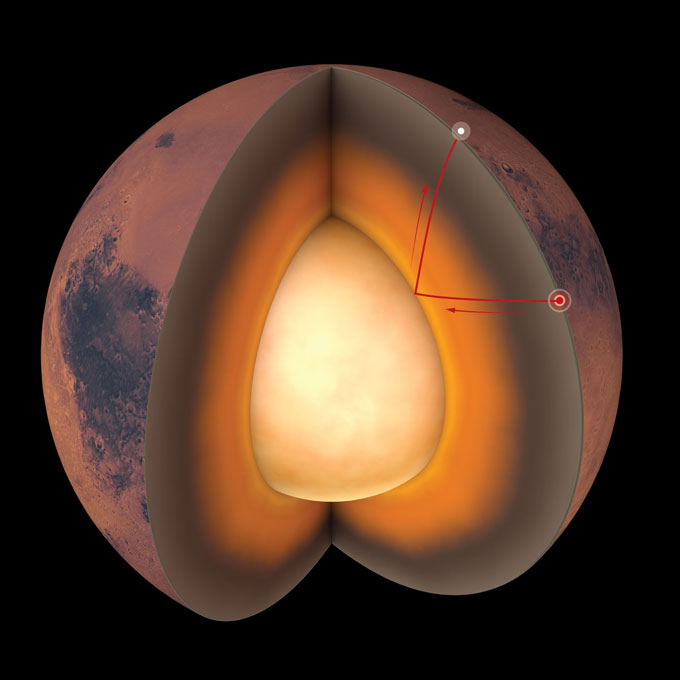In Today’s Deep Space Extra… Boeing cleared by NASA for Starliner’s Orbital Flight Test-2 launch on July 30. The InSight Mars lander reveals the deep interior of the Red Planet.
Human Space Exploration
SLS engineering tests to accompany pre-launch checkouts for Artemis I
Coalition Members in the News – Boeing, Jacobs, United Launch Alliance
NASAspaceflight.com (7:22): NASA’s Artemis I, the first integrated test flight of the Space Launch System (SLS) rocket and an uncrewed Orion spacecraft promises to be as rigorous on the ground as in flight during the pre-launch Integrated Test and Checkout (ITCO) of the flight and ground systems. ITCO will feature special engineering tests for the Orion and SLS program elements. Mathematical models used up to this point to predict how the systems would interact as they were assembled on the launch platform at NASA’s Kennedy Space Center (KSC) will now calibrate the analytical models while verifying launch readiness.
NASA clears Boeing Starliner for launch on second unpiloted test flight
Coalition Members in the News – Boeing, United Launch Alliance
Spaceflightnow.com (7/22): Boeing’s Orbital Flight Test-2 (OFT-2) mission passed a Flight Readiness Review (FRR) on Thursday, clearing the way for a planned launch on July 30 at 2:53 p.m. EDT, from the Cape Canaveral Space Force Station, Florida. The FRR is a meeting between Boeing, NASA, ULA (which will launch Starliner), Roscosmos, JAXA, and other International Space Station (ISS) partners where they discuss the status of the spacecraft’s systems. The teams presented technical in-depth assessments, ensuring that the spacecraft, ISS, and launch vehicle are ready to support Starliner’s flight.
Russia delays detaching old Space Station docking port while testing new research module in orbit
Space.com (7/22): The departure of Russia’s two-decade old Pirs airlock and docking module from the Russian segment of the International Space Station (ISS) has been delayed from Friday until Saturday. The delay will provide time for additional in-flight assessments of Russia’s Nauka Multipurpose Research Module, which was launched on Wednesday from the Baikonur Cosmodrome and intends to replace Pirs. Nauka has experienced a few issues during its journey to the orbiting lab, necessitating a change of plans. It’s been difficult to gauge the nature and severity of Nauka’s problems because Roscosmos, the Russian space agency, hasn’t revealed many details. But some information is coming from outside observers who reported that Nauka’s main engines had not been functioning properly.
Space Science
Marsquakes reveal the Red Planet boasts a liquid core half its diameter
Science News (7/22): Data gathered by NASA’s Mars InSight lander, which touched down on the Red Planet in November 2018, has revealed new information about the crust, mantle, and core. Three scientific assessments published in the journal Science on Thursday suggest that the crust has three layers, with signatures of volcanic activity across the two upper layers. The sub-crust mantle on Mars on a whole is much thinner than on Earth. The Martian core, though not as dense as the Earth’s, is much larger than expected. The liquid core is half the planet’s diameter. It’s not clear yet whether Mars has a solid inner core like the Earth.
Mars helicopter Ingenuity gearing up for 10th Red Planet flight this weekend
Space.com (7/22): The 10th flight of the Ingenuity helicopter could happen as early as Saturday. The flight will investigate Raised Ridges, a collection of rock features inside Mars’ Jezero Crater from which Ingenuity’s robotic partner, NASA’s Perseverance rover, may end up collecting some samples for future return to Earth.
Other News
Senators push for action on space traffic management
SpaceNews.com (7/23): Yesterday the Senate Space Subcommittee held a hearing on space traffic management (STM), space situational awareness (SSA), and space debris. Senator Cynthia Lummis (R-WY), the subcommittee’s ranking member, expressed concern that it has been three years since the release of Space Policy Directive 3 which directed the implementation of and STM system, but the Department of Commerce’s Office of Space Commerce has been slow to develop the open architecture data repository (OADR) that is needed. The OADR would combine space situational awareness data from government and commercial sources, which can then be used to provide services such as collision warnings. Kevin O’Connell, who led the office from 2018 until the end of the last administration, said the delay was very much a result of lack of resources. At the hearing, witnesses in general warned that delays in establishing norms of behavior for safe space operations not only posed a risk to space safety but also to U.S. leadership in space.

